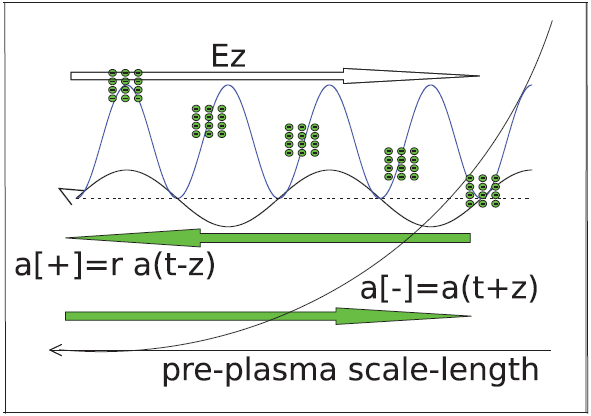The influence of pre-plasma in laser–matter interaction at relativistic intensities has attracted much attention in both experimental and theoretical investigations, because of its significant effects on a number of applications.
However the underlying physics, the increase in the generation efficiency of energetic electrons with the increase of pre-plasma scale length and laser intensity, and the acceleration mechanism of super-high energetic electrons with kinetic energy greatly exceeding the pondermotive energy, is still unclear.
To thoroughly understand the underlying physics, a theoretical scaling law for the cut-off electron energy based on analyzing the electrons’ motion in the presence of counter-propagating lasers and external electric field in a dense plasma environment should be figured out.
Recently, researchers at Shanghai Institute of Optics and Fines Mechanics (SIOM) of Chinese Academy of Sciences have studied the generation of super-high energetic electrons influenced by pre-plasma in relativistic intensity laser–matter interaction in a one-dimensional slab approximation with particle-in-cell simulations.
The related results were published in Nuclear Fusion.
(http://iopscience.iop.org/article/10.1088/0029-5515/57/1/016007/pdf)
In this study, they answered the above two questions. They considered different pre-plasma scale lengths and laser intensities, showing an increase in both particle number and cut-off kinetic energy of electrons with the increase of pre-plasma scale length and laser intensity, the cut-off kinetic energy greatly exceeding the corresponding laser ponderomotive energy.
Furthermore, they proposed a two-stage electron acceleration model to identify thesource of super-high energetic electrons.
The first stage is synergetic acceleration by longitudinal electric field and two counter-propagating laser pulses; a scaling law is obtained theoretically, with its efficiency depending on the pre-plasma scale length and laser intensity. The second stage is related to the intense electrostatic potential building in front of the target and the accompanying reflection of electrons by this electrostatic potential barrier; the potential building and electron energy enhancement are figured out analytically and confirmed through electrostatic PIC simulations.
This work was supported by the National Natural Science Foundation of China, the National Basic Research Program of China.

Figure: Schematic demonstration of the electron dynamics in the presence of two counter-propagating laser waves and longitudinal electric field Ez. The white arrow represents the direction of charge separation electric field, and green arrows represent the directions of incident and reflected laser beams. Blue curve represent the γ factor of reflected laser beam, accelerating electrons (green dots) in its propagation direction. (Image by Wu Dong)
Home | About SIOM | Newsroom | International | Admissions | Publications | Contact
@ Shanghai Institute of Optics and Fine Mechanics Tel:02169918000 沪ICP备05015387号-1 Technical support:Qingyun Software